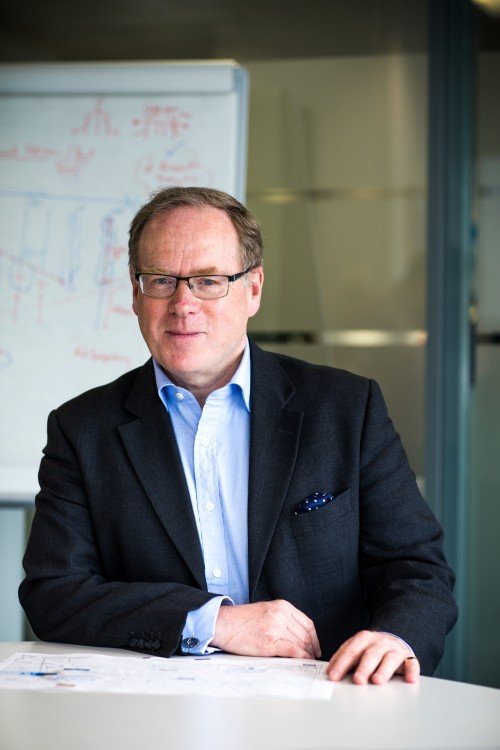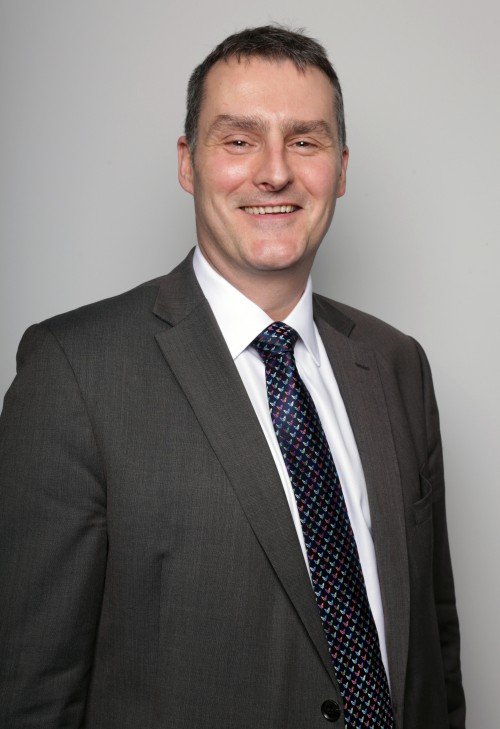
Andrew Wolstenholme, photographed by Luke Mardell
SHP’s Roz Sanderson spoke to Andrew Wolstenholme OBE and Steve Hails, Crossrail about the health initiatives in place at Crossrail and the steps being taken to improve the health of employees.
Tell us about some of the health initiatives you have in place at Crossrail.
Steve: Crossrail takes a three-pronged approach to occupational health and wellbeing. There’s an occupational hygiene element, engineers and scientists evaluating the work and the associated risks that come with that, and an occupational health element, the pre-employment medicals, the ongoing health surveillance and interventions when required. There is also health and wellbeing, which is how we engage with individuals on diet, exercise, smoking and general lifestyle choices allowing them to make informed decisions.
Even before construction commenced on Crossrail we created and released a standard called Healthy by Design which requires designers to consider the health risks associated with their designs and how to eliminate those risks.
We continue to monitor and audit against our expectations with each of our contractors, reviewing what occupational hygienists are doing. We look at how they are monitoring dust noise and vibration levels and what programmes they have in place to minimise their impact. Importantly, we also look at how they are eliminating risk in the first instance including how they are investing in technology to eliminate the exposure to hazardous substances.
More traditionally, in health and wellbeing, we encourage our contractors to promote the importance of the workforce looking after their health, seeking advice from various areas around physical and mental health. We have recently placed an increased focus on mental health with mental health first-aiders now being trained to be the ‘go-to’ person in the first instance for someone who may be suffering with metal health issues.

Steve Hails, photgraphed by James O Jenkins
Andrew: At the Health in Construction Leadership Group we looked at the state of health in the construction industry. Crossrail has already looked at ways to improve health, from considering shift patterns through to conducting research on our environments, particularly in terms of dust and silica and carbon components and how we can eliminate that risk from the front line. I want to make sure this part of our legacy will be taken forward by other major programmes.
As Co-Chair of the Construction Leadership Council (CLC), I am also able to look at the issue strategically and support the industry in asking the right questions to ensure we place a renewed focus on this agenda and make progress.
Steve: We have invested in research with the Institute of Occupational Medicine which analysed the atmospheres within our tunnels. We looked at levels of general respirable dust and more specifically crystalline silica against the statutory Workplace Exposure Limits (WEL). We also looked at Diesel Engine Exhaust Emissions (DEEE) in particular black carbon and elemental carbon the latter of which we benchmarked against European levels in the absence of a current UK WEL. The findings have been published as part of a scientific paper presented at the international BOHS conference.
Andrew: We also have something called Stepping Up Week where we stop and think about health and safety. This ranges from presentations about eating and health and wellness, to physiotherapy sessions and mindfulness sessions. These are all things that are now coming into the workforce that 5 years ago, even before Crossrail started you wouldn’t really expect.
In terms of carbon emissions. You obviously have a responsibility to local residents as well. Can you tell us about any initiatives in this area?
Andrew: The Mayor has set some very clear targets for London, construction contributes to that as well as road traffic. We carried out an initiative to make sure that we first understand the carbon particulates we are putting into the atmosphere and secondly to understand, and where possible mandate, the control of those carbon particulates.
Steve: We are the first construction project that has specified the use of diesel particulate filters on construction plant. It was a contractual requirement with all of our contractors. The project has moved 8 million tonnes of excavated material, more than 85 per cent has gone via rail or river therefore reducing the road vehicle usage and local pollution levels.
What do you think is the next big focus for health and safety in construction?
Steve: Speaking specifically about health risks, we need to be clearly focused on substances that have the potential to cause harm. What is our next asbestos? . But, other than these physical aspects we mustn’t lose sight of the psychological aspects, focusing on mental health and mental ill health within our industry. The figures are staggering and as an industry we need to do something here and now.
Andrew: The important thing is for companies to keep asking that question, and to continue to research. This Health in Construction Leadership Group was incredibly important as it helped the industry understand how important it is to focus on health, as well as safety. Together, we will push the frontier of how the industry works – with the mind-set of eliminating these risks.
Andrew Wolstenholme has a background in civil engineering, having worked with Arup and Schal Associates. He joined BAA plc in 1997 as construction director for the Heathrow Express rail link. With a passion to improve the UK’s construction industry, Andrew was invited to lead an industry review in 2009. His report, ‘Never Waste a Good Crisis’, has helped steer government policy in this important area. Andrew joined the Balfour Beatty Group in 2009 as Director of Innovation and Strategic Capability. He was awarded an OBE for services to the construction industry in the same year. Andrew joined Crossrail as its Chief Executive Officer on 1 August 2011. Andrew is also the Chair of the Government Construction Strategy & Infrastructure Cost Review Joint Steering Committee.
Steve Hails is a Chartered Member of IOSH, Associate Member of IEMA and with a Masters degree in Health, Safety & Environment, Steve progressed into HS&E management through his career spent in engineering, within the nuclear industry, and also through the manufacturing sector.Steve has previously worked for Nuclear Electric, Procter & Gamble and Siemens Wind Power. Steve joined Crossrail in early 2012 as Health and Safety Director. He represents Crossrail in a number of Health & Safety groups including the Construction Health Leadership Group, the Public Health Responsibility Deal and the UK Rail Health & Wellbeing Policy Group.
What makes us susceptible to burnout?
In this episode of the Safety & Health Podcast, ‘Burnout, stress and being human’, Heather Beach is joined by Stacy Thomson to discuss burnout, perfectionism and how to deal with burnout as an individual, as management and as an organisation.
We provide an insight on how to tackle burnout and why mental health is such a taboo subject, particularly in the workplace.




Interesting initiatives from senior managers, but do they cascade down to the sharp end of construction and do they deal with real h&s issues? In my experience they don’t.
While very commendable and welcome in all of the talk about health initiatives being carried out. nowhere has there been any evidence that Lead surveys are being carried out before and during the course of this project. There was a question asked in the forward article what is the next Asbestos. Well I can tell you it is the debilitating effect lead can and does have on those who come in contact with it and affected by it. In my travels in construction the lack of full knowledge of this issue is disconcerting and causes frustration that this does not… Read more »
“What is our next asbestos?”. Surprisingly, perhaps, it is inextricably linked with asbestos work, both surveys and removal… The comprehensive air sampling and analysis work described in the article appears to have overlooked the ‘elephant in the room’ which is LEAD! This is all the more strange given the neuro-toxic, brain-damaging effects of this widespread contaminant – a measurable and avoidable contributor to deteriorating mental health. Worthy efforts to address mental health issues need to recognise the often significant contribution that occupational lead exposure can make to early onset dementia, Alzheimer’s, Parkinson’s and other age-related diseases. And what about the… Read more »